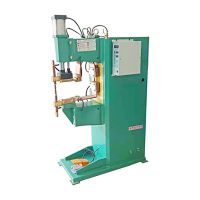The spot welding process is a metal connection that forms a bond. During welding, the weldment is heated locally by welding current, and pressure is applied to the contact heating point of the weldment to form a solder joint. Spot welding is a high-speed, economical connection method, it is suitable for the manufacture of lap joints, joints do not need to be airtight, thickness of less than 5mm stamping rolled sheet components. Spot welding process is currently used in various industrial sectors, not only can weld low carbon steel and low alloy steel, but also can weld high carbon steel, high manganese steel and stainless steel, aluminum alloy, titanium alloy and other materials composed of parts.
The selection of spot welding process parameters: the process parameters that affect spot welding include the structural diameter of the welding electrode, welding energy, welding time and welding pressure. According to the welding speed and welding effect can be divided into fast welding, medium speed welding, ordinary welding three conditions, for the workpiece requirements of high welding strength, welding deformation of small occasions, the use of high-power, short time strong specification fast welding. For the workpiece with less stringent requirements, the ordinary welding method of low power and long time can be used, so that a relatively small welding equipment can be selected, and the impact on the power grid is also relatively small. It is usually selected according to the material and thickness of the workpiece, referring to the welding condition table of the material, first determine the end face shape and size of the electrode, then preliminarily select the electrode pressure and welding time, and then adjust the welding current, weld the sample with different currents, and then adjust the electrode pressure, welding time and current within the appropriate range after checking that the diameter of the molten core meets the requirements. The sample is welded and inspected until the quality of the solder joint fully meets the requirements specified in the technical conditions. The most commonly used method for testing samples is the tear method, and the mark of a good quality solder joint is that there is a round hole in one piece of the tear sample and a round boss in the other piece. Thick plates or quenched materials sometimes cannot tear out round holes and convex tables, but the diameter of the molten core can be judged by the shear fracture. If necessary, it is also necessary to carry out low-power measurement, tensile test and X-ray inspection to determine the penetration rate, shear strength and whether there are shrinkage holes and cracks. When selecting the process parameters with the sample, the differences between the sample and the workpiece in the shunt, the influence of ferromagnetic substances, and the assembly gap should be fully considered, and the appropriate adjustment should be made.
The main factors affecting the welding quality of spot welding joints are welding current, electrode pressure, welding time, prepressure and rest time, welding electrode diameter and so on.
1. Welding current
The source of heat required for the fusion core formed by spot welding is the heat generated by the current passing through the resistance of the welding area. In the case of other conditions given, the size of the welding current determines the welding penetration of the molten core. When welding low carbon steel, the average penetration rate of molten core is 30 ~ 70% of the thickness of the steel plate, and the welding strength is higher when the penetration rate of molten core is 45 ~ 50%. When the welding current exceeds a certain standard value, continuing to increase the current can only increase the rate of molten core, but not improve the joint strength. Therefore, it is very uneconomical in terms of manufacturing costs. If the current is too large, it will also produce defects such as too deep indentation and welding burn through.
2, electrode pressure
The influence of electrode pressure on the size of molten core is also relatively large in spot welding. Too high electrode pressure will make the indentation too deep, and will accelerate the deformation and loss of the welding electrode. The lack of pressure is easy to produce shrinkage holes, and the welding electrode will burn out due to the increase of contact resistance and shorten its service life.
3. Welding time
In spot welding, the core size is mainly controlled by welding time. When other welding parameters are unchanged, the longer the welding time, the larger the core size. In the case that the welding strength is relatively high, the welding energy and the welding time should be relatively large. Special attention should be paid to the lengthening welding time will increase the energy consumption of the welder, but also increase the wear of the electrode and reduce the service life of the equipment.


